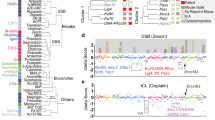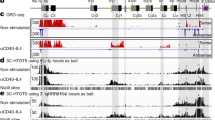Abstract
Immunoglobulin heavy chain (IgH) class switch recombination (CSR) takes place between large switch (S) regions that precede exons of the constant region. The precise functions of the S region are controversial, although transcription of the S region targets CSR. We have tested the effects of deletion, inversion and replacement of the endogenous 12-kilobase Sγ1 region on CSR in vivo. Here we show that Sγ1 is required for CSR, that CSR is effected by a 1-kilobase sequence that generates a G-rich transcript, and that inversion of Sγ1 or the G-rich sequence decreases CSR. We conclude that Sγ1 function is dependent on orientation and lacks an absolute requirement for common S region motifs. We propose that single-stranded DNA stabilized by transcription-dependent, higher order structures is a primary substrate of CSR.
This is a preview of subscription content, access via your institution
Access options
Subscribe to this journal
Receive 12 print issues and online access
$209.00 per year
only $17.42 per issue
Buy this article
- Purchase on Springer Link
- Instant access to full article PDF
Prices may be subject to local taxes which are calculated during checkout




Similar content being viewed by others
References
Manis, J.P., Tian, M. & Alt, F.W. Mechanism and control of class-switch recombination. Trends Immunol. 23, 31–39 (2002).
Honjo, T., Kinoshita, K. & Muramatsu, M. Molecular mechanism of class switch recombination: linkage with somatic hypermutation. Annu. Rev. Immunol. 20, 165–196 (2002).
Dunnick, W., Hertz, G.Z., Scappino, L. & Gritzmacher, C. DNA sequences at immunoglobulin switch region recombination sites. Nucleic Acids Res. 21, 365–372 (1993).
Lee, C.G., Kondo, S. & Honjo, T. Frequent but biased class switch recombination in the Sμ flanking regions. Curr. Biol. 8, 227–230 (1998).
Shanmugam, A., Shi, M.J., Yauch, L., Stavnezer, J. & Kenter, A.L. Evidence for class-specific factors in immunoglobulin isotype switching. J. Exp. Med. 191, 1365–1380 (2000).
Ma, L., Wortis, H.H. & Kenter, A.L. Two new isotype-specific switching activities detected for Ig class switching. J. Immunol. 168, 2835–2846 (2002).
Reaban, M.E. & Griffin, J.A. Induction of RNA-stabilized DNA conformers by transcription of an immunoglobulin switch region. Nature 348, 342–344 (1990).
Reaban, M.E., Lebowitz, J. & Griffin, J.A. Transcription induces the formation of a stable RNA-DNA hybrid in the immunoglobulin α switch region. J. Biol. Chem. 269, 21850–21857 (1994).
Daniels, G.A. & Lieber, M.R. RNA:DNA complex formation upon transcription of immunoglobulin switch regions: implications for the mechanism and regulation of class switch recombination. Nucleic Acids Res. 23, 5006–5011 (1995).
Dempsey, L.A., Sun, H., Hanakahi, L.A. & Maizels, N. G4 DNA binding by LR1 and its subunits, nucleolin and hnRNP D, A role for G-G pairing in immunoglobulin switch recombination. J. Biol. Chem. 274, 1066–1071 (1999).
Tian, M. & Alt, F.W. Transcription-induced cleavage of immunoglobulin switch regions by nucleotide excision repair nucleases in vitro. J. Biol. Chem. 275, 24163–24172 (2000).
Mizuta, R. et al. Molecular visualization of immunoglobulin switch region RNA/DNA complex by atomic force microscope. J. Biol. Chem. 278, 4431–4434 (2003).
Mussmann, R., Courtet, M., Schwager, J. & Du Pasquier, L. Microsites for immunoglobulin switch recombination breakpoints from Xenopus to mammals. Eur. J. Immunol. 27, 2610–2619 (1997).
Tashiro, J., Kinoshita, K. & Honjo, T. Palindromic but not G-rich sequences are targets of class switch recombination. Int. Immunol. 13, 495–505 (2001).
Luby, T.M., Schrader, C.E., Stavnezer, J. & Selsing, E. The μ switch region tandem repeats are important, but not required, for antibody class switch recombination. J. Exp. Med. 193, 159–168 (2001).
Lutzker, S., Rothman, P., Pollock, R., Coffman, R. & Alt, F.W. Mitogen- and IL-4-regulated expression of germ-line Igγ2b transcripts: evidence for directed heavy chain class switching. Cell 53, 177–184 (1988).
Berton, M.T., Uhr, J.W. & Vitetta, E.S. Synthesis of germ-line γ1 immunoglobulin heavy-chain transcripts in resting B cells: induction by interleukin 4 and inhibition by interferon γ. Proc. Natl. Acad. Sci. USA 86, 2829–2833 (1989).
Xu, M. & Stavnezer, J. Structure of germline immunoglobulin heavy-chain γ1 transcripts in interleukin 4 treated mouse spleen cells. Dev. Immunol. 1, 11–17 (1990).
Rothman, P. et al. Structure and expression of germline immunoglobulin γ3 heavy chain gene transcripts: implications for mitogen and lymphokine directed class-switching. Int. Immunol. 2, 621–627 (1990).
Rothman, P. et al. Structure and expression of germ line immunoglobulin heavy-chain ε transcripts: interleukin-4 plus lipopolysaccharide-directed switching to Cε . Mol. Cell. Biol. 10, 1672–1679 (1990).
Collins, J.T. & Dunnick, W.A. Germline transcripts of the murine immunoglobulin γ2a gene: structure and induction by IFN-γ. Int. Immunol. 5, 885–891 (1993).
Jung, S., Rajewsky, K. & Radbruch, A. Shutdown of class switch recombination by deletion of a switch region control element. Science 259, 984–987 (1993).
Zhang, J., Bottaro, A., Li, S., Stewart, V. & Alt, F.W. A selective defect in IgG2b switching as a result of targeted mutation of the Iγ2b promoter and exon. EMBO J. 12, 3529–3537 (1993).
Bottaro, A. et al. S region transcription per se promotes basal IgE class switch recombination but additional factors regulate the efficiency of the process. EMBO J. 13, 665–674 (1994).
Lorenz, M., Jung, S. & Radbruch, A. Switch transcripts in immunoglobulin class switching. Science 267, 1825–1828 (1995).
Harriman, G.R., Bradley, A., Das, S., Rogers-Fani, P. & Davis, A.C. IgA class switch in Iα exon-deficient mice. Role of germline transcription in class switch recombination. J. Clin. Invest. 97, 477–485 (1996).
Seidl, K.J. et al. An expressed neor cassette provides required functions of the Iγ2b exon for class switching. Int. Immunol. 10, 1683–1692 (1998).
Daniels, G.A. & Lieber, M.R. Strand specificity in the transcriptional targeting of recombination at immunoglobulin switch sequences. Proc. Natl. Acad. Sci. USA. 92, 5625–5629 (1995).
Kinoshita, K., Tashiro, J., Tomita, S., Lee, C.G. & Honjo, T. Target specificity of immunoglobulin class switch recombination is not determined by nucleotide sequences of S regions. Immunity 9, 849–858 (1998).
von Schwedler, U., Jack, H.M. & Wabl, M. Beswitched. The looping out model for immunoglobulin class switching. New Biol. 8, 657–662 (1990).
Muramatsu, M. et al. Specific expression of activation-induced cytidine deaminase (AID), a novel member of the RNA-editing deaminase family in germinal center B cells. J. Biol. Chem. 274, 18470–18476 (1999).
Muramatsu, M. et al. Class switch recombination and hypermutation require activation-induced cytidine deaminase (AID), a potential RNA editing enzyme. Cell 102, 553–563 (2000).
Revy, P. et al. Activation-induced cytidine deaminase (AID) deficiency causes the autosomal recessive form of the Hyper-IgM syndrome (HIGM2). Cell 102, 565–575 (2000).
Petersen, S. et al. AID is required to initiate Nbs1/γ-H2AX. Nature 414, 660–665 (2001).
Petersen-Mahrt, S.K., Harris, R.S. & Neuberger, M.S. AID mutates E. coli suggesting a DNA deamination mechanism for antibody diversification. Nature 418, 99–103 (2002).
Weill, J.C. et al. Ig gene hypermutation: a mechanism is due. Adv. Immunol. 80, 183–202 (2002).
Papavasiliou, F.N. & Schatz, D.G. Somatic hypermutation of immunoglobulin genes: merging mechanisms for genetic diversity. Cell 109 (Suppl.), S35–S44 (2002).
Chester, A., Scott, J., Anant, S. & Navaratnam, N. RNA editing: cytidine to uridine conversion in apolipoprotein B mRNA. Biochim. Biophys. Acta. 1494, 1–13 (2000).
Di Noia, J. & Neuberger, M.S. Altering the pathway of immunoglobulin hypermutation by inhibiting uracil-DNA glycosylase. Nature 419, 43–48 (2002).
Rada, C. et al. Immunoglobulin isotype switching is inhibited and somatic hypermutation perturbed in UNG-deficient mice. Curr. Biol. 12, 1748–1755 (2002).
Stavnezer, J. & Bradley, S.P. Does activation-induced deaminase initiate antibody diversification by DNA deamination? Trends Genet. 18, 541–543 (2002).
Storb, U. & Stavnezer, J. Immunoglobulin genes: generating diversity with AID and UNG. Curr Biol. 12, R725–R727 (2002).
Dudley, D.D. et al. Internal IgH class switch region deletions are position-independent and enhanced by AID expression. Proc. Natl. Acad. Sci. USA 99, 9984–9989 (2002).
Nagaoka, H., Muramatsu, M., Yamamura, N., Kinoshita, K. & Honjo, T. Activation-induced deaminase (AID)-directed hypermutation in the immunoglobulin Sμ region: implication of AID involvement in a common step of class switch recombination and somatic hypermutation. J. Exp. Med. 195, 529–534 (2002).
Yancopoulos, G.D. et al. Secondary genomic rearrangement events in pre-B cells: VHDJH replacement by a LINE-1 sequence and directed class switching. EMBO J. 5, 3259–3266 (1986).
Stavnezer, J. et al. Immunoglobulin heavy-chain switching may be directed by prior induction of transcripts from constant-region genes. Proc. Natl. Acad. Sci. USA 85, 7704–7708 (1988).
Sakai, E., Bottaro, A., Davidson, L., Sleckman, B.P. & Alt, F.W. Recombination and transcription of the endogenous Ig heavy chain locus is effected by the Ig heavy chain intronic enhancer core region in the absence of the matrix attachment regions. Proc. Natl. Acad. Sci. USA 96, 1526–1531 (1999).
Sleckman, B.P., Khor, B., Monroe, R. & Alt, F.W. Assembly of productive T cell receptor δ variable region genes exhibits allelic inclusion. J. Exp. Med. 188, 1465–1471 (1998).
Chen, J., Lansford, R., Stewart, V., Young, F. & Alt, F.W. RAG-2-deficient blastocyst complementation: an assay of gene function in lymphocyte development. Proc. Natl. Acad. Sci. USA 90, 4528–4532 (1993).
Hein, K. et al. Processing of switch transcripts is required for targeting of antibody class switch recombination. J. Exp. Med. 188, 2369–2374 (1998).
Radbruch, A., Muller, W. & Rajewsky, K. Class switch recombination is IgG1 specific on active and inactive IgH loci of IgG1-secreting B-cell blasts. Proc. Natl. Acad. Sci. USA 83, 3954–3957 (1986).
Hummel, M., Berry, J.K. & Dunnick, W. Switch region content of hybridomas: the two spleen cell Igh loci tend to rearrange to the same isotype. J. Immunol. 138, 3539–3548 (1987).
Winter, E., Krawinkel, U. & Radbruch, A. Directed Ig class switch recombination in activated murine B cells. EMBO J. 6, 1663–1671 (1987).
Schultz, C. et al. Patterns and extent of isotype-specificity in the murine H chain switch DNA rearrangement. J. Immunol. 144, 363–370 (1990).
Jung, S., Siebenkotten, G. & Radbruch, A. Frequency of immunoglobulin E class switching is autonomously determined and independent of prior switching to other classes. J. Exp. Med. 179, 2023–2026 (1994).
Ratmeyer, L., Vinayak, R., Zhong, Y.Y., Zon, G. & Wilson, W.D. Sequence specific thermodynamic and structural properties for DNA-RNA duplexes. Biochemistry 33, 5298–5304 (1994).
Yu, K., Chedin, F., Hsieh, C.-L., Wilson, T.E. & Lieber, M.R. R-loops at immunoglobulin class switch regions within the chromosomes of stimulated B cells. Nature Immunology, advance online publication, 7 april 2003 (doi:10.1038/ni919).
Chaudhuri, J., Tian, M., Khuong, C., Chua, K., Pinaud, E. & Alt, F.W. Transcription targeted DNA deamination by the AID antibody diversification enzyme. Nature, in press.
Acknowledgements
We thank L. Davidson, D. Foy, A. Williams, N. Stokes and C. Kennedy for mouse work, and J. Manis, C. Bassing, A. Zarrin and J. Chaudhuri for comments on the manuscript. This work was supported by US National Institutes of Health grant AI31541 (to F.W.A.) and NIH training grant AI07512 (to M.T.). K.C. is supported by a Pfizer Postdoctoral Fellowship in Rheumatology/Immunology. F.W.A is an Investigator and R.S. is an Associate of the Howard Hughes Medical Institute.
Author information
Authors and Affiliations
Corresponding author
Ethics declarations
Competing interests
The authors declare no competing financial interests.
Supplementary information
Rights and permissions
About this article
Cite this article
Shinkura, R., Tian, M., Smith, M. et al. The influence of transcriptional orientation on endogenous switch region function. Nat Immunol 4, 435–441 (2003). https://doi.org/10.1038/ni918
Received:
Accepted:
Published:
Issue Date:
DOI: https://doi.org/10.1038/ni918
This article is cited by
-
Mechanisms of human lymphoid chromosomal translocations
Nature Reviews Cancer (2016)
-
Mutations, kataegis and translocations in B cells: understanding AID promiscuous activity
Nature Reviews Immunology (2016)
-
Complexities due to single-stranded RNA during antibody detection of genomic rna:dna hybrids
BMC Research Notes (2015)
-
Erratum to: The role of activation-induced deaminase in antibody diversification and genomic instability
Immunologic Research (2014)
-
The role of activation-induced deaminase in antibody diversification and genomic instability
Immunologic Research (2013)



